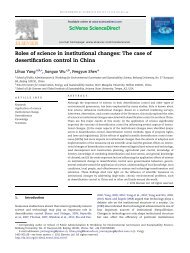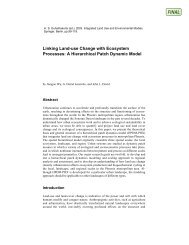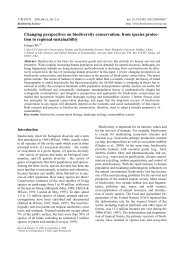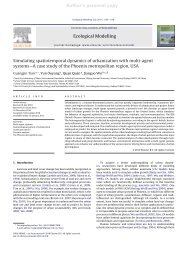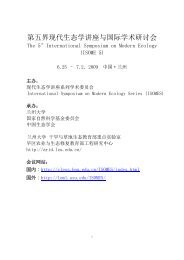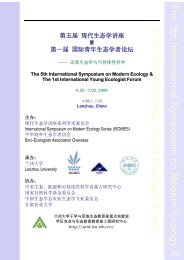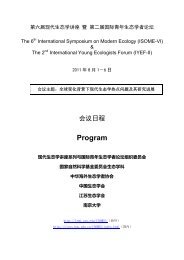Landscape ecology - Arizona State University
Landscape ecology - Arizona State University
Landscape ecology - Arizona State University
You also want an ePaper? Increase the reach of your titles
YUMPU automatically turns print PDFs into web optimized ePapers that Google loves.
Comp. by: THAMIZHVEL V Stage: Galleys Chapter No.: 575 Title Name: ESST<br />
Page Number: 0 Date:7/12/11 Time:00:19:36<br />
Au2<br />
14 L<br />
t3:1<br />
t3:2<br />
t3:3<br />
t3:4<br />
t3:5<br />
t3:6<br />
t3:7<br />
t3:8<br />
t3:9<br />
t3:10<br />
t3:11<br />
t3:12<br />
t3:13<br />
t3:14<br />
t3:15<br />
t3:16<br />
t3:17<br />
<strong>Landscape</strong><br />
<strong>Landscape</strong> Ecology. Table 3 Some commonly used landscape metrics [4, 52]<br />
<strong>Landscape</strong> metric Abbreviation Description<br />
Patch shape index PSI A measure of the shape complexity of an individual patch:<br />
PSI ¼ P p<br />
2 ffiffiffiffi<br />
Ap<br />
where P is the perimeter of a patch, and A is the area of the patch. D = 1 for<br />
circles; D = 1.1283 for squares; and D = 1.1968 for a rectangle (2 L by L). 1/D<br />
is called “compactness” (see Forman [4]).<br />
Perimeter/area ratio PAR A measure of the shape complexity of an individual patch:<br />
PAR = P/A<br />
where P is the perimeter of a patch, and A is the area of the patch.<br />
Number of patches NP The total number of patches in the landscape.<br />
Patch density PD The number of patches per square kilometer (i.e., 100 ha).<br />
Total edge TE The sum of the lengths of all edge segments (unit: meter).<br />
Edge density ED The total length of all edge segments per hectare for the class or landscape<br />
of consideration (unit: m/ha).<br />
Patch richness PR The number of different patch types in the landscape.<br />
Patch richness density PRD The number of patch types per square kilometer (or 100 ha).<br />
Shannon’s diversity index SHDI A measure of patch diversity in a landscape that is determined by both the<br />
number of different patch types and the proportional distribution of area<br />
among patch types:<br />
H ¼ Pm<br />
pi lnðpiÞ i¼1<br />
where m is the total number of patch types and pi is the proportion of the<br />
landscape area occupied by patch type i.<br />
Dominance index D A measure of the degree of dominance by one or a few patch types in<br />
a landscape:<br />
D ¼ Hmax þ Pm<br />
pi ln pi<br />
i¼1<br />
where Hmax is the maximum diversity when all patch types are present in<br />
equal proportions, m is the total number of patch types, and pi is the<br />
proportion of the landscape area occupied by patch type i. Small values of<br />
D tend to indicate that landscapes with numerous land use types of similar<br />
proportions.<br />
Largest patch index LPI The ratio of the area of the largest patch to the total area of the landscape<br />
(unit: percentage).<br />
Mean patch size MPS The average area of all patches in the landscape (unit: ha).<br />
Patch size standard<br />
deviation<br />
Patch size coefficient of<br />
variation<br />
Ecology<br />
PSSD The standard deviation of patch size in the entire landscape (unit: ha).<br />
PSCV The standard deviation of patch size divided by mean patch size for the<br />
entire landscape (unit: percentage).<br />
<strong>Landscape</strong> shape index LSI A modified perimeter/area ratio of the form:<br />
LSI ¼ 0:25E pffiffi<br />
A<br />
where E is the total length of patch edges and A is the total area of the<br />
landscape (unitless).




